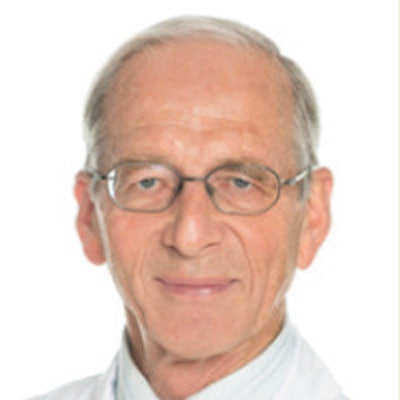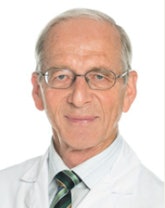
Do you know the real radiation risks and what to teach students as well as junior doctors? Are you uncertain answering questions from concerned patients? Have you ever heard of "hormesis" or "adaptive response"? If not, then please read below an interview with the expert Dr. Peter Vock, professor emeritus at the University of Bern and senior consultant radiologist at Bern University Hospital (Inselspital) in Bern, Switzerland. Get your facts right for the future (and learn about the radiation research uncertainties that still pose many questions).
ECR Today: As a radiology trainee I was taught by a consultant that one CT head scan carried a 1 in 3,000 risk of causing a brain tumor. Similar things are mentioned in various teaching files. Is this actually true?
 Dr. Peter Vock is professor emeritus at the University of Bern and senior consultant radiologist at Inselspital University Hospital in Bern, Switzerland.
Dr. Peter Vock is professor emeritus at the University of Bern and senior consultant radiologist at Inselspital University Hospital in Bern, Switzerland.Dr. Peter Vock: A number of studies have observed similar findings of an increased brain tumor rate in patients (mostly children) having undergone CT examinations as compared with controls. Unfortunately, all of these publications have methodological deficiencies and, thus, epidemiological proof of such a relation has not been shown.
Most importantly, studies in the U.K., in Australia, and in Taiwan observed an elevated relative risk but did not analyze the reasons for performing CT; this opens the probability of "confounding by indication" or "reverse causation": early symptoms of undetected tumor, or of factors that predispose to tumor, might have been the indications for the CT scans. Furthermore, when these tumors were compared with other radiation-induced tumors (e.g., those observed in Japanese atomic bomb survivors), several inconsistences were observed, regarding the location of tumors (brain tumors even after CT scans of other body areas), the types of tumors encountered, the latency period, and the most sensitive, age at exposure.
Nonetheless, such publications have increased awareness of the risk of medical diagnostic uses of ionizing radiation. (Reference: ICRP 2013 Proceedings, Annals of the ICRP, J.D. Boice, Radiation epidemiology and recent pediatric computed tomography studies.)
Which common misconceptions about radiation risks have you come across and what are the evidence-based facts?
Justification of a diagnostic examination using ionizing radiation requires that the benefit is more important than the risk. Many of us have difficulties in comparing an immediate benefit with a small, but very likely significant, risk that might only become effective after decades. It is my biggest concern that some people get anxious in this situation and reject an important exam even when there is an obvious benefit, whereas others (both referrers, radiologists, and patients) consider the scientific uncertainty of the risk level at very low doses (below around 40 mSv of effective dose) to be an argument for ignoring the risk altogether.
Could exposure to low levels of radiation actually be good for you? What is your personal view of the theory of "hormesis" and the concept of adaptive response? Would you visit a "radiation spa"?
To start with the answer to the last question: I would never visit a "radiation spa." But, to be honest, scientific data also exist that support "hormesis," with a beneficial radiation effect at very low doses, and both theories fall within the confidence intervals. By the way, other hypotheses cannot be excluded either, e.g., adaptive response with a threshold effect, or even a bystander effect with over-proportional risk at very low doses.
My pragmatic approach is to use the linear relation (LNT model) for justification purposes, being aware of the scientific uncertainty. There is a new additional argument for not using hormesis or adaptive response in medical radiation protection: In the recent INWORKS study, nuclear plant workers in three countries with an average cumulative dose to the colon of 20.9 mSv (median 4.1 mSv) had a significantly increased mortality from solid cancers.
First, this clearly supports the LNT theory, and second, this type of occupational exposure is not fully different from medical diagnostic exposure, where patients often undergo repeated examinations over time, easily reaching around 20 mSv. (Reference: Richardson DB, Cardis E, Daniels RD, et al., Risk of cancer from occupational exposure to ionizing radiation: Retrospective cohort study of workers in France, the United Kingdom, and the United States (INWORKS). BMJ. 20 October 2015, Vol. 351, pp. h5359.)
What do you think medical students should know about radiation protection and radiation risks? Where should this be included in the undergraduate curriculum?
The ESR [European Society of Radiology) has developed a curriculum for undergraduate radiological education, which can be found within the education section of myESR.org and defines the knowledge, skills, competences, and attitudes required. I fully support this curriculum.
What do you think junior doctors and radiology trainees should know about radiation protection and radiation risks?
The ESR similarly has suggested a European Training Curriculum for Radiology, which can also be found on myESR.org, that defines the knowledge, skills, competences, and attitudes required, and (for radiation protection) follows publication No.175 of the European Commission: Guidelines on radiation protection education and training of medical professionals in the European Union.
Which radiation incidents (related to medical exposure settings) have you come across? What can happen if precautions are not in place and safety issues are disregarded?
To my knowledge, the term of radiation incidents has not been defined uniformly but is usually used for the so-called tissue reactions (previous term: deterministic effects); in contrast to cancerogenesis and hereditary effects (the so-called stochastic effects), tissue reactions do not appear below a relatively high, local threshold dose, and above this dose their severity increases with the dose.
Excluding incidents in radio-oncology, two types of tissue reactions have been observed in diagnostic and interventional radiology: hair loss under inappropriately high and repeated exposure during brain perfusion CT perfusion scans in stroke patients, and skin injuries under mostly interventional fluoroscopy; these reactions range from acute hair loss and inflammation to exudation, poorly healing exulceration and chronic changes, such as permanent hair loss, dyspigmentation, induration, and ulcers. Both types of radiation incidents are avoidable by appropriate planning and optimization.
What is your opinion about screening programs that involve ionizing radiation (particularly screening programs that suggest repeat CT scans)?
There are a number of problems with all types of screening programs that are not specific to those using ionizing radiation but which, of course, also apply to them. Strict quality assurance and formal approval of such programs, based on scientific facts, by a public body are most important prerequisites.
Using imaging procedures with ionizing radiation asks for an even more critical justification and optimization. As these are asymptomatic individuals, benefits are often less evident than in a severely sick patient, and risks mean mostly that a normal member of the population will become a patient. Individuals should therefore be provided with as much information as possible prior to giving consent, including the possibility of false-positive findings and their sometimes risky and costly consequences.
Which personal experiences have you had as a patient or accompanying a relative or friend receiving medical care, and how have these encounters changed your practice?
I have been lucky until now and do not have a lot of experience with medical care. However, the few situations have shown me the need for a more patient-centric orientation of all medical processes, which may be quite difficult, above all in a public health system.
Can you recommend anywhere to find further information about these important topics?
Sorry, this is a project of its own and cannot be summarized in a few sentences. However, important information can be found at the websites of the International Commission on Radiological Protection, ICRP, the International Atomic Energy Agency, IAEA, the United Nations' Scientific Committee on the Effects of Atomic Radiation, UNSCEAR, and the European Commission. Furthermore, ESR eLearning modules cover several different aspects of radiation protection.
Interview conducted by Dr. Christiane Nyhsen, consultant radiologist at Sunderland Royal Hospital, U.K.; member of the editorial advisory board of AuntMinnieEurope.com; and former chairperson of the ESR Radiology Trainees Forum.
Originally published in ECR Today on 3 March 2016.
Copyright © 2016 European Society of Radiology


















